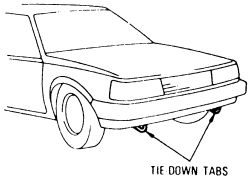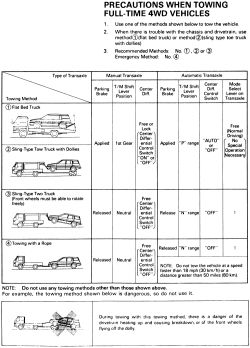
See Figures 1 and 2
The absolute best way to have the car towed or transported is on a flat-bed or rollback transporter. These units are becoming more common and are very useful for moving disabled vehicles quickly. Most vehicles have lower bodywork and undertrays which can be easily damaged by the sling of a conventional tow truck; an operator unfamiliar with your particular model can cause severe damage to the suspension or drive line by hooking up chains and J-hooks incorrectly.
If a flatbed is not available (you should specifically request one), the car may be towed by a hoist or conventional tow vehicle. Front wheel drive cars with automatic transaxle must be towed with the drive wheels off the ground. FWD cars with a manual transaxle can be towed with either end up in the air or with all four wheels on the ground. You need only remember that the transaxle must be in neutral, the parking brake must be off and the ignition switch must be in the ACC position. The steering column lock is not strong enough to hold the front wheels straight under towing.
The Corolla All-Trac vehicle presents its own towing problems. Since the front and rear wheels are connected through the drive system, all four wheels must be considered in the towing arrangement. If a flatbed is not available, the All-Trac should be towed with the front end elevated. As the rear wheels roll on the ground, the front wheels will turn. They must be clear of the hoist and sling equipment. If the vehicle cannot be towed front-end-up, both ends must be elevated, using a set of dolly wheels.
Most vehicles have conveniently located tie-down hooks at the front of the vehicle. These make ideal locations to secure a rope or chain for towing the car or extracting it from an off-road excursion. The vehicle may only be towed on hard surfaced roads and only in a normal or forward direction.
A driver must be in the towed vehicle to control it. Before towing, the parking brake must be released and the transaxle put in neutral. Do NOT flat tow the vehicle if the brakes, steering, axles, suspension or drive line is damaged. If the engine is not running, the power assists for the steering and brakes will not be operating. Steering and braking will require more time and much more effort without the assist.

 |  |
Fig. Fig. 1: Tie down locations

 |  |
Fig. Fig. 2: Towing procedures for 4WD models